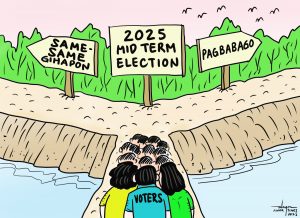Since the start of the quarantine period resorted to by the government to arrest the spread of the deadly CoViD 19 in the Philippines, we had not been to the Church to attend Holy Masses. Prior to the global health pandemic we made it a regular part of our life every Sunday and other days with important Catholic Church commemorations.
But even as we had been unable to attend Holy Masses in the last three months due to the government restrictions on holding mass gatherings including religious services, we had been hearing and witnessing the celebration of the ritual every Sunday through television. Yes, it is virtual attendance to the Holy Mass although it has deprived us of the opportunity to receive the body of the Lord Jesus Christ through the Holy Communion.
Last Sunday, June 14, 2020, the televised mass centered on the commemoration of the Solemnity of the Most Holy Body and Blood of Christ. The mass that we heard and saw through Channel 5 was celebrated by Most Rev. Bishop Broderick Pabillo, D.D., the designated overseer of the Archdiocese of Manila after Cardinal Juan Tagle was asked by His Eminence Pope Francis to join him in the Vatican.
Pabillo is a known critic of the Duterte administration and, without doubt, the person of the President. The Manila bishop is not hiding this fact even in some of his homilies during the masses where he was the celebrant.
In last Sunday’s mass however, we sensed that the Most Reverend Bishop was importuning the government to treat the Church and the Holy Mass celebration different from other activities that gather a huge crowd of people.
In his homily Bishop Pabillo asked: Why is celebration of the Holy Mass lumped in the category of entertainment and other related public gatherings? The bishop seems to wonder aloud why is it that under the general community quarantine (GCQ) regime some activities conducted with a huge number of people are supposed to be permitted but the attendees are still restricted to not more than ten individuals only.
Attending Holy Masses, the Bishop postulated, is a manifestation of the Catholic faithful’s continuing effort to be one big community wherever they are in the world. He emphasized in his homily that the Church clearly understands the temporary suspension of the holding of masses because the attendees who are in huge numbers are most vulnerable to infection of the deadly virus. What with the faithful seated close to each other.
But the Manila archdiocese overseer however, thought that the down-grading of the quarantine category from enhanced community quarantine (ECQ) to GCQ is an indication that the government is convinced it is slowly gaining headway in the fight against the health emergency. And that is why, he said in his homily, that activities like meetings, religious gatherings, parties and even concerts are allowed subject to limitations in the number of attendees.
Unfortunately for the Church, the number of attendees in masses is still to be limited to ten persons only. This is where the bishop insinuated he could not find any sense at all.
We agree with the Manila bishop fully for this particular issue. Yes, the Church is a community of faithful known to be compliant with the norms of religious practices since time immemorial. And we assume that this is also the reason why the Church leaders did not raise howls of protest when the government ordered for the suspension of the holding of Holy Masses as part of the measures in fighting the spread of the CoViD 19.
We are also one with Bishop Pabillo in his idea that allowing only ten persons to attend masses does not make any sense in this time of the GCQ.
Yes, under the down-graded quarantine, more people are now allowed to work, more businesses are authorized to open, malls are back in business. And in doing all these, the government issued strict guidelines to ensure that the spread of the virus will be contained. Thus, there are such protocols on wearing protective face masks, social distancing, frequent washing of hands, and most of all just stay home for those who have nothing extremely important to do outside.
It is our take that the Church being a community of obedient faithful, is one that can easily be made to obey the various health protocols in place. It sure is also concerned with the members of its community. Thus, there is no reason for the Church not to institute measures intended to protect its followers.
Yes, the Church can very well make do with social distancing considering the huge space of the venues of masses. It can, as it has already done, do away with the personal contacts like hugging, kissing, the “mano” to the priest, the kissing of the statue of saints, and even the dipping of hands in the holy water among church goers shortly before the national lockdown.
Above all, we believe it is easier for the Church to control the number of faithful wanting to attend masses as most churches are fenced and the number of seats and its total capacity is already determined.
Moreover, the Church is not for profit, it needs to fill the venue to capacity to be able to recover whatever is spent for the holding of the celebration. In other words, it can do with 50 percent of the church capacity filled or even less. But with only ten individuals in attendance, what community of faithful is there?
We believe that the Bishop’s proposition for the Inter-Agency Task Force (IATF) on the fight against CoViD 19 to reconsider its restriction on the number of mass attendees to ten deserves a serious look by that government body.
And if the down-grading of the quarantine to the less restrictive category is for the economy to slowly be back on its feet, we strongly feel that it would do well for the government that the restrictions on the holding of Eucharistic perpetual sacrifice – the Holy Mass – be alleviated to a certain degree.
After all, the Filipinos who the government is endeavoring to protect from the pandemic are the same Filipinos who are members of the community of religious faithful. So, why not the government just lay down the parameters with which the Church authorities have to base their own moves?
From there the government can make it clear to the Church leaders their responsibilities and accountabilities as to the consequences of their action.


